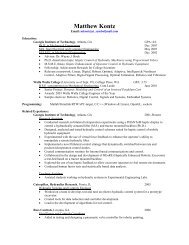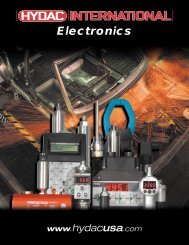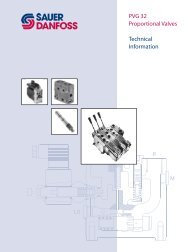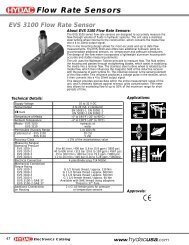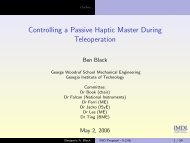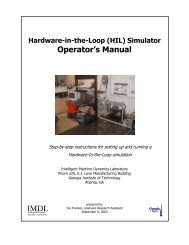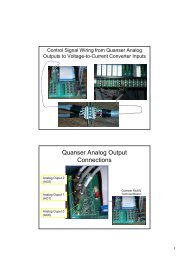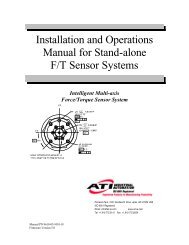haptic control of hydraulic machinery using proportional valves
haptic control of hydraulic machinery using proportional valves
haptic control of hydraulic machinery using proportional valves
You also want an ePaper? Increase the reach of your titles
YUMPU automatically turns print PDFs into web optimized ePapers that Google loves.
Some <strong>of</strong> the first researchers to propose the application <strong>of</strong> force feedback to <strong>hydraulic</strong><br />
systems such as excavators were Starzewski and Skibniewski [107]. They predicted<br />
enhancements due to coordinated motion and “feel” or <strong>haptic</strong> feedback that<br />
could be provided by such an interface. This concept paper predicted the commercial<br />
use <strong>of</strong> such systems when it was technically and economically feasible. Patents related<br />
to <strong>haptic</strong> or force feedback devices to <strong>control</strong> <strong>hydraulic</strong> machines were received<br />
by Caterpillar Inc. [16] in the same year that his paper was published and by Kraft<br />
[75] two years later. Like many other robotic researchers with an interest in excavators,<br />
Skibniewski turned toward autonomous robotic excavators that could work<br />
independently <strong>of</strong> humans instead <strong>of</strong> with humans [38, 63, 84, 126, 134, 139]. Others<br />
in academia [9, 76, 121, 133] and the nuclear industry [8, 7, 15, 78, 59] have focused on<br />
coordinated teleoperation <strong>of</strong> excavators with various levels <strong>of</strong> <strong>haptic</strong> feedback. By the<br />
early 1990s, this topic was explored by the nuclear industry: HAZ-TRAK remotely<br />
operated excavator [8, 78] and a telerobotic small emplacement excavator [15]. Better<br />
documented work was conducted at the University <strong>of</strong> British Columbia on resolved<br />
mode teleoperation by Sepehri et al. [121] and force feedback <strong>of</strong> <strong>hydraulic</strong> machines<br />
by Parker et al. [109]. An impedance based teleoperation scheme designed for transparency<br />
was later implemented on a mini-excavator and presented by Salcudean et<br />
al. [120] and Tafazoli et al. [133]. Krishnaswamy and Li used a passive <strong>control</strong> based<br />
on bond graphs to <strong>control</strong> a backhoe. One advantage <strong>of</strong> the passivity approach that<br />
it is inherently safe.<br />
Coordinated <strong>control</strong> is a subtle, but a pr<strong>of</strong>ound improvement over conventional<br />
hand <strong>control</strong>lers that work in joint space. Using joysticks that individually <strong>control</strong> the<br />
joints <strong>of</strong> the manipulator puts a “high perceptual and psychomotor demand” on the<br />
operator [141, 142]. Using coordinated motion <strong>control</strong> and a single hand <strong>control</strong>ler<br />
whose motion corresponds directly to the slave manipulator reduces this mental load<br />
by doing the inverse kinematics for the operator. Human-in-the-loop experiments<br />
12



